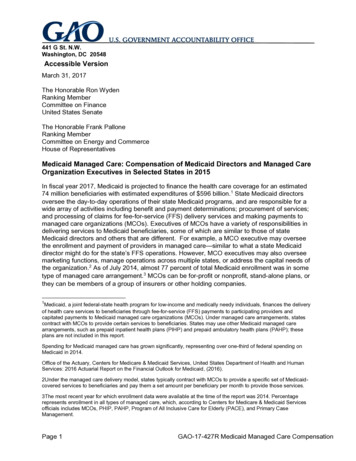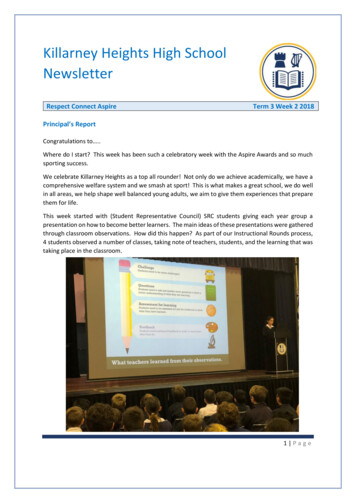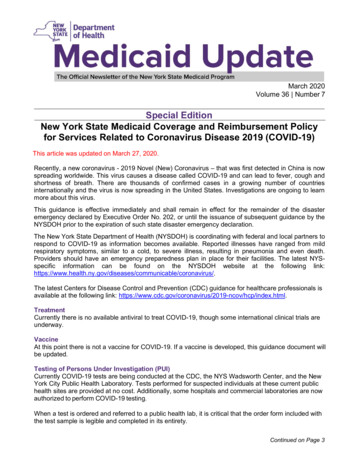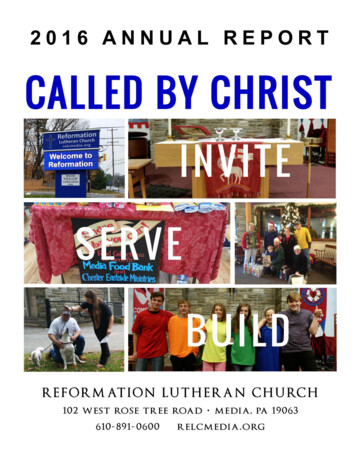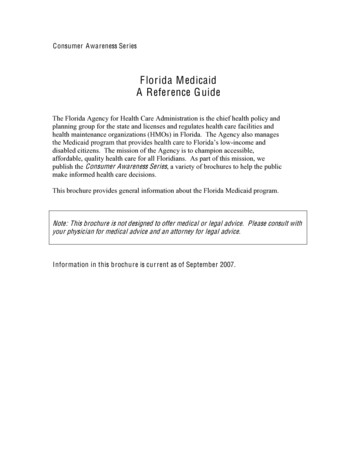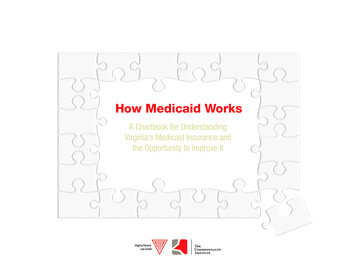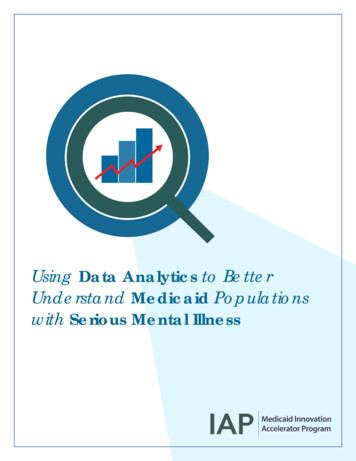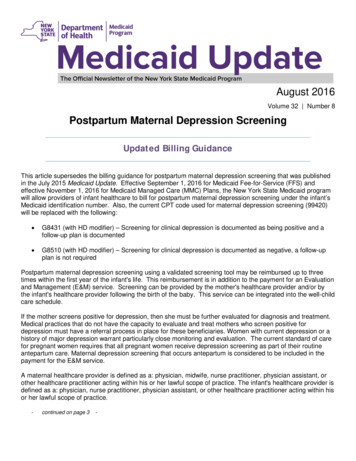
Transcription
August 2016Volume 32 Number 8Postpartum Maternal Depression ScreeningUpdated Billing GuidanceThis article supersedes the billing guidance for postpartum maternal depression screening that was publishedin the July 2015 Medicaid Update. Effective September 1, 2016 for Medicaid Fee-for-Service (FFS) andeffective November 1, 2016 for Medicaid Managed Care (MMC) Plans, the New York State Medicaid programwill allow providers of infant healthcare to bill for postpartum maternal depression screening under the infant’sMedicaid identification number. Also, the current CPT code used for maternal depression screening (99420)will be replaced with the following: G8431 (with HD modifier) – Screening for clinical depression is documented as being positive and afollow-up plan is documented G8510 (with HD modifier) – Screening for clinical depression is documented as negative, a follow-upplan is not requiredPostpartum maternal depression screening using a validated screening tool may be reimbursed up to threetimes within the first year of the infant's life. This reimbursement is in addition to the payment for an Evaluationand Management (E&M) service. Screening can be provided by the mother's healthcare provider and/or bythe infant's healthcare provider following the birth of the baby. This service can be integrated into the well-childcare schedule.If the mother screens positive for depression, then she must be further evaluated for diagnosis and treatment.Medical practices that do not have the capacity to evaluate and treat mothers who screen positive fordepression must have a referral process in place for these beneficiaries. Women with current depression or ahistory of major depression warrant particularly close monitoring and evaluation. The current standard of carefor pregnant women requires that all pregnant women receive depression screening as part of their routineantepartum care. Maternal depression screening that occurs antepartum is considered to be included in thepayment for the E&M service.A maternal healthcare provider is defined as a: physician, midwife, nurse practitioner, physician assistant, orother healthcare practitioner acting within his or her lawful scope of practice. The infant's healthcare provider isdefined as a: physician, nurse practitioner, physician assistant, or other healthcare practitioner acting within hisor her lawful scope of practice.-continued on page 3-
Andrew M. CuomoGovernorState of New YorkHoward A. Zucker, M.D., J.D.CommissionerNew York StateDepartment of HealthJason A. HelgersonMedicaid DirectorOffice of Health Insurance ProgramsThe Medicaid Update is a monthly publication of the New York State Department of Health.In This Issue Postpartum Maternal Depression Screening – Updated Billing Guidance . coverAll ProviderseMedNY 2017 ICD-10 Update Testing Opening September, 2016 . 4New York Medicaid EHR Incentive Program Update .5Policy & Billing GuidanceChange to Medicaid Reimbursement of Medicare Part C Copayment and Coinsurance Liabilities . . . 6Physician Signature - Billing Update for Home Health Care Providers . . . . 7Incontinence Supply Management Program September 1, 2016 8Change in Reimbursement Policy for Compounded Alpha-Hydroxyprogesterone Caproate (17-P) .12Medicaid Reimbursement to Article 28 Clinics for Oral Assessments by Dental Hygienists withCollaborative Practice Agreements .15Direct Admit for Observation Services 17Medicaid Coverage of Allergen Immunotherapy Services – Updates . .19Pharmacy UpdateMedicaid Fee-for-Service Prescription Drug Coverage for “Emergency Services Only” Category of Eligibility . .23New Legislation Enacted for Drugs Used for Detoxification or Maintenance Treatment ofOpioid Addiction for Medicaid Fee-for-Service & Medicaid Managed Care Beneficiaries . .24Medicaid Managed Care to Implement an Opioid Fill Limit of Four Prescriptions Every 30 Days 24Provider Directory . . . .25August 2016 New York State Medicaid Updatepg. 2
-Continued from Cover-Screening and Referral ToolsThere are multiple, validated depression screening tools available for use. These tools usually can becompleted in less than 10 minutes. Some examples of recommended screening tools include the EdinburghPostnatal Depression Scale (EPDS) and the Patient Health Questionnaire-9 (PHQ-9). Additional information isavailable on validated screening tools for maternal depression.Please refer to the following links for helpful referral information: th care/perinatal/maternal depression/providers/additional resources.htmDirectory of Office of Mental Health FacilitiesPostpartum Resource Center of New York/Emergency ResourcesBilling GuidanceIf maternal depression screening is provided postpartum by the maternal healthcare provider, the service canbe reimbursed in addition to the E&M visit. Effective September 1, 2016 for FFS and November 1, 2016 forMMC, providers should bill for this service using CPT code G8431 in conjunction with the “HD” modifier for apositive depression screen of the mother and G8510 in conjunction with the “HD” modifier when the screeningreturns a negative result. These two new “G” series codes replace CPT code 99420 (The Administration andInterpretation of Health Risk Assessment Instrument - Health Hazard Appraisal) currently being used formaternal depression screening. Upon the effective date outlined above, the CPT code 99420 will no longer beactive in the Medicaid billing system.If maternal depression screening is performed on the same day as the infant's primary care visit (E&M) by theinfant's healthcare provider, one claim can be submitted for both services using the appropriate “G” seriescode (G8431/G8510) with the HD modifier under the infant's Medicaid identification number. Alternatively,providers may bill this service separately under the mother’s Medicaid identification number.Reminders New York State Medicaid record-keeping requirements apply to all services offered and provided tobeneficiaries. HIPAA-compliant consent to treat and share information necessary for treatment is the responsibility ofall providers. Medical providers who have additional questions on requirements should consult withtheir own counsel.Medicaid FFS policy questions may be directed to the Office of Health Insurance Programs' Division ofProgram Development and Management at (518) 473-2160. Questions regarding MMC reimbursement and/ordocumentation requirements should be directed to the enrollee’s MMC ****************August 2016 New York State Medicaid Updatepg. 3
All ProviderseMedNY 2017 ICD-10 Update Testing OpeningSeptember, 2016On September 6, 2016, eMedNY’s Provider Testing Environment (PTE) will be available for submitters to begintesting their Medicaid claims with updated 2017 ICD-10 diagnosis codes and their inpatient hospital claims thatutilize updated 2017 ICD-10 procedure codes. Test claims must be submitted for dates of service on orafter September 1, 2016, up to the date of the test submission, in order to be adjudicated with the ICD-10updates provided by CMS. Future dates of service are not allowed.What is PTE? The eMedNY PTE allows New York State Medicaid trading partners to test batch and real-timeElectronic Data Interchange transactions against the same validation and adjudication logic as the eMedNYproduction environment. In order to allow for iterative testing, PTE does not apply edits involving duplicate andnear-duplicate claims, nor prior authorization submissions. Additionally, no claim or prior authorizationrequests are pended in PTE.How to Use the eMedNY Provider Testing Environment All submitters must use an active ETIN when submitting transactions to PTE.Most existing eMedNY access methods may be used except ePACES, VeriFone POS, AudioResponse Unit (ARU), and paper.For all ASC X12 inbound and outbound PTE transactions, “Test Indicator” in ISA15 must be set to “T”,otherwise they will be processed through the production environment.Only 2 files per day, per user with a maximum of 50 claims on a file are allowed.The PTE weekly adjudication cycle ends on Fridays and remittances are delivered the following weekaccording to the submitter’s/provider’s production settings.More information about ICD-10 changes may be found at www.emedny.org/icd. Questions may be directed tothe eMedNY Call Center at 800-343-9000 or via email to ***************************************August 2016 New York State Medicaid Updatepg. 4
All ProvidersNew York Medicaid EHR Incentive Program UpdateThe New York Medicaid Electronic Health Record (EHR) Incentive Program provides financial incentives toeligible professionals and hospitals to promote the transition to EHRs. Providers who practice using EHRs arein the forefront of improving quality, reducing costs and addressing health disparities. Since December 2011over 783 million in incentive funds have been distributed within 24,261 payments to New York StateMedicaid providers.24,261 783 PaymentsMillion PaidAre youeligible?For more information, visit www.emedny.org/meipassDid you know?2016 is the last year that eligible professionals (EPs) may begin participation in the New York Medicaid EHRIncentive Program. An EP may receive up to 63,750 over the course of six years, which includes a lump sumpayment of 21,250 for the first participation year wherein the EP can demonstrate adopt, implement, orupgrade to certified EHR technology. Thereafter, the EP may receive 8,500 for each of the remaining fiveyears for demonstrating meaningful use.Visit https://ehrincentives.cms.gov/hitech/login.action to register for the program. The provider’s registrationmust match the enrollment information with New York Medicaid. Upon successful registration, the providermust then submit an attestation to the New York Medicaid EHR Incentive Program in order to be consideredfor the incentive payment. 2021 will be the last year of the program.MEIPASS AvailabilityThe New York Medicaid EHR Incentive Program Administrative Support Service (MEIPASS) is currently closeddue to important maintenance being performed on the system for meaningful use attestations for payment year2015 and beyond. It is anticipated that MEIPASS will reopen in early fourth quarter of calendar year 2016.Announcements will be made via LISTSERV and the program website. Program support will continue to beavailable by phone at 877-646-5410.Questions? Contact hit@health.ny.gov for program clarifications and *******************August 2016 New York State Medicaid Updatepg. 5
Policy & Billing GuidanceChange to Medicaid Reimbursement of Medicare Part CCopayment and Coinsurance LiabilitiesThis Article Supersedes the Article Published in the July 2016 Medicaid UpdateEffective July 1, 2016, an amendment to New York State Social Services Law* changes Medicaidreimbursement of Medicare Part C (Medicare Advantage or Medicare managed care) copayment and/orcoinsurance liabilities for outpatient services provided to dually eligible Medicaid beneficiaries. Dually eligiblebeneficiaries are those individuals having both Medicare and Medicaid coverage.Presently the Medicaid program pays the full copayment or coinsurance amounts for Medicare Part C claims.Retroactively to July 1, 2016, Medicaid will reimburse at the rate of eighty-five percent (85%) of the MedicarePart C copayment or coinsurance amount.The Department is in the process of making the necessary eMedNY System changes to enable theimplementation of the new payment policy. Implementation will be applied retroactively pending Systemsupport. Paid claims will then be adjusted automatically to reflect the new cost-sharing limits.This change will affect institutional claims and professional claims when submitting claims for Medicaidreimbursement of a Medicare Part C copayment or coinsurance. This change will also apply to pharmacyclaims for drugs and supplies when submitted via a NCPDP transaction or as a professional claim.There is no change to the current reimbursement methodology of Medicare Part C copayment/coinsuranceamounts for ambulance providers and psychologists. Medicaid will continue to reimburse these providers inthe full Medicare Part C copayment/coinsurance amounts.Note: A provider of a Medicare Part C benefit cannot seek to recover any copayment, or coinsurance amountfrom Medicare/Medicaid dually eligible beneficiaries. The provider is required to accept the Medicare Part Chealth plan payment and any Medicaid payment as payment in full for the service. The Medicaid beneficiarymay not be billed for any Medicare Part C copayment/coinsurance amount that is not reimbursed by Medicaid.Providers will be notified by a future Medicaid Update article prior to claim adjustments being made.Questions? Please contact the Office of Health Insurance Programs, Division of Program Development andManagement at (518) 473-2160.*A new subparagraph (iv) was added to paragraph (d) of subdivision 1 of Section 367-a of the Social Services ***************August 2016 New York State Medicaid Updatepg. 6
Policy & Billing GuidancePhysician Signature - Billing Update for Home Health Care ProvidersA recent change to New York Codes, Rules & Regulations (NYCRR), Title 10, Sections 763.7 & 766.4 nowallows certified home health agencies (CHHAs), long term home health care programs (LTHHCPs), andlicensed home care services agencies (LHCSAs) up to 12 months to obtain a physician’s signature on ordersfor services, including verbal and telephone orders. The regulations can be found at:http://www.health.ny.gov/regulations/recently adopted.Home care providers cannot submit claims for Medicaid Fee-for-Service beneficiaries until the signedphysician order is obtained. In order to accommodate the provisions of the revised regulation, the 90-daytimely filing requirement found in NYCRR Title 10, Section 540.6 has been extended to exempt appropriatelysubmitted home care claims from certain timely filing edit denials.Home care providers must submit their claims within 30 days of the date of the signed physician order. NoDelay Reason Code should be included with these claims.In cases where a claim is returned to a provider due to data insufficiency or claiming errors (rejected ordenied), it must be corrected and resubmitted within 60 days of the date of notification to the provider. Claimsnot correctly resubmitted within 60 days, or those continuing to not be payable after the second resubmission,are neither valid nor enforceable.All claims must be finally submitted to the fiscal agent and be payable within two years from the date the care,services or supplies were furnished in order to be valid and enforceable.Billing questions should be directed to the eMedNY Call Center at **************************August 2016 New York State Medicaid Updatepg. 7
Policy & Billing GuidanceIncontinence Supply Management ProgramSeptember 1, 2016As announced in the June 2016 Medicaid Update, beginning September 1, 2016, all adult and youth sized diapersdispensed to all Medicaid beneficiaries must meet minimum product specifications established by the Department ofHealth. These minimum standards apply to all adult and youth sized products dispensed to Medicaid beneficiariesresiding in community settings by Fee-for-Service, Managed Care and Managed Long Term Care Medicaid providers.The Department has awarded a preferred vendor supply contract to Twin Med, LLC for incontinence products to bepurchased by Medicaid providers. Medicaid providers who purchase incontinence supplies from Twin Med will receivecompetitive pricing and a formulary that has been approved by the Department as meeting the new minimum qualitystandards. Medicaid providers are not required to verify incontinence product quality standards if the products arepurchased from Twin Med, LLC. To set up an account with Twin Med, please visit the preferred vendor’s New Yorkwebsite at www.twinmedny.com or contact Twin Med by phone at 1-844-886-3639.The preferred vendor purchase pricing and formulary are as follows:New York State Incontinence Supply Contracted Purchase Price by HCPCS Code(HCPCS codes denoted with an asterisk are subject to minimum quality standards)HCPCS CODEBRIEF DESCRIPTIONCONTRACTED PRICEA4554Disposable Underpads 0.15T4521 *Disposable Adult Small Diaper 0.25T4522 *Disposable Adult Medium Diaper 0.25T4523 *Disposable Adult Large Diaper 0.34T4524 *Disposable Adult Extra Large Diaper 0.41T4529Disposable Pediatric Small/Medium Diaper 0.16T4530Disposable Pediatric Large Diaper 0.28T4533 *Disposable Youth Diaper 0.32T4535Disposable liners/pads 0.15T4537Reusable Underpad, Bed Size 7.00T4539Reusable Diaper, any size 6.00T4540Reusable Underpad, Chair size 3.95T4543 *Disposable Bariatric Diaper (waist/hip 62”) 0.65August 2016 New York State Medicaid Updatepg. 8
New York State Incontinence Supply ProgramTwin Med, LLC Approved Product Formulary as of 8/1/2016HCPCSProductsT4521 *First Quality Prevail Briefs, Small, (20”-31”) 96/CSCovidien Quilted Briefs, Small, (20”-31”) 96/CST4522 *First Quality Procare Brief, Medium, (34”-44”) 96/CSNu-Fit Briefs Medium, (34”-44”) 96/CSFirst Quality Procare Underwear, Medium (34”-46”) 80/CSFirst Quality Procare Plus Underwear, Medium, (34”-46”) 100/CSCovidien Quilted Briefs, Medium, (34”-44”), 100/CSCovidien Surecare Underwear, Medium, (34”-48”) 80/CST4523 *First Quality Procare Briefs, Large, (45”-58”) 72/CSFirst Quality Nu-Fit Briefs, Large, (45”-58”) 72/CSFirst Quality Procare Underwear, Large, (46”-58”) 72/CSFirst Quality Procare Plus Underwear, Large, (46”-58”)Covidien Simplicity Quilted Briefs, Large, (45”-58”) 72/CSCovidien Surecare Underwear, Large, (44”-54”) 72/CST4524 *First Quality Procare Briefs, X-Large, (59”-64”) 60/CSFirst Quality Nu-Fit Briefs, X-Large, (59”-64”) 60/CSFirst Quality Procare Underwear, X-Large, (58”-68”) 56/CSFirst Quality Procare Plus Underwear, X-Large, (58”-68”) 100/CSCovidien Simplicity Quilted Brief, X-Large, (59”-64”) 60/CSCovidien Surecare Underwear, X-Large, (48”-66”) 56/CST4533 *First Quality Prevail Briefs, Youth, (15”-22”) 96/CSFirst Quality Prevail Extra Underwear, Youth/Small, (20”-34”) 88/CST4543 *First Quality Procare Briefs, 2-XL, (62”-73”) 48/CSFirst Quality Prevail Extra Underwear, 2-XL (68”-80”) 48/CSCovidien Surecare Underwear, 2-XL (60”-80”) 48/CSA4554ProCure Fluff Underpad, (23”-36”) 150/CSCovidien Tendersorb Fluff Underpad (23”-36”) 150/CSFirst Quality Procare Fluff Underpad, (23”-36”) 150/CST4529First Quality Cuties Baby Diapers – Newborn 169/CSFirst Quality Cuties Baby Diapers – Size 1 200/CSFirst Quality Cuties Baby Diapers – Size 2 168/CSFirst Quality Cuties Baby Diapers – Size 3 144/CSAugust 2016 New York State Medicaid Updatepg. 9
New York State Incontinence Supply ProgramTwin Med, LLC Approved Product Formulary as of 8/1/2016T4530First Quality Cuties Baby Diapers – Size 4 124/CSFirst Quality Cuties Baby Diapers – Size 5 108/CSFirst Quality Cuties Baby Diapers – Size 6 92/CSFirst Quality Cuties Baby Diapers – Size 7 80/CSFirst Quality Cuties Boy Training Pants – Size 2 104/CSFirst Quality Cuties Boy Training Pants – Size 3 92/CSFirst Quality Cuties Boy Training Pants – Size 4 76/CSFirst Quality Cuties Girl Training Pants – Size 2 104/CSFirst Quality Cuties Girl Training Pants – Size 3 92/CSFirst Quality Cuties Girl Training Pants – Size 4 76/CST4535ProCure Premium Absorbent Liners 4” x 10” 200/CSProCure Premium Absorbent Liners 7” x 17” 200/CSFirst Quality Prevail Moderate Pads 9.25” 180/CSFirst Quality Prevail Moderate Long Pads 11” 144/CSCovidien SureCare Bladder Control Pads 4” x 10” 132/CSCovidien SureCare Bladder Control Pads 4” x 14” 168/CST4537ProCure Reusable Bed Pad, Twill 30” x 36” 24/CSProCure Reusable Bed Pad, Twill 34” x 36” 24/CSProCure Reusable Bed Pad, Plaid 30” x 36” 24/CSProCure Reusable Bed Pad, Plaid 34” x 36” 24/CST4539ProCure Products Reusable Diaper, Medium 60/CSProCure Products Reusable Diaper, Large 60/CSProCure Products Reusable Diaper, X-Large 60/CSProCure Products Reusable Diaper, 2XLarge 60/CSProCure Products Reusable Fitted Brief, Medium, 24/CSProCure Products Reusable Fitted Brief, Large, 24/CSProCure Products Reusable Fitted Brief, X-Large, 24/CSProCure Products Reusable Fitted Brief, 2XLarge, 24/CST4540ProCure Products Reusable Chair Pad, Twill 60/CSProCure Products Reusable Chair Pad, Plaid, 60/CSAugust 2016 New York State Medicaid Updatepg. 10
Providers will continue to be able to purchase incontinence products from alternative suppliers as long as theproducts provided meet the established minimum quality standards. Medicaid providers who choose topurchase incontinence supplies from an alternative supplier, however, are responsible for ensuring that anyproduct dispensed meets the minimum product specifications established by the Department and will beresponsible for obtaining independent testing results for these products (even if they are the same as or similarto products on the approved formulary). Only products purchased from Twin Med, LLC are exempt from thedocumentation requirement.The Department will incorporate review of incontinence product minimum quality specifications into routine prepayment and post-payment reviews and other routine audit processes. Providers must maintain independenttesting documentation for a six-year period following reimbursement for any product not purchased from TwinMed, LLC and have the ability to produce such documentation upon audit or claims review. The Departmentwill also investigate any complaints received from Medicaid beneficiaries or other parties concerning Medicaidproviders dispensing incontinence products which do not meet the established minimum product specifications.For questions about the Incontinence Supply Management Program, contact the Bureau of Medical Review bytelephone at 1-800-342-3005 or by email at ***********************************August 2016 New York State Medicaid Updatepg. 11
Policy & Billing GuidanceChange in Reimbursement Policy for CompoundedAlpha-Hydroxyprogesterone Caproate (17-P)This Article Supersedes All Previously Published Billing GuidanceNew York State Medicaid will no longer reimburse for the compounded version of the drug 17 alphahydroxyprogesterone caproate (17-P) unless the U.S. Food and Drug Administration (FDA) approved productis unable to meet the medical needs of an individual patient. This policy applies to both Medicaid Fee-forService and Medicaid Managed Care. This coverage policy is consistent with the recommendations of theFDA regarding compounded versions of drugs. The FDA approved version of this drug, Makena , will continueto be reimbursed by Medicaid.Background:The FDA approved Makena in February 2011 to reduce the risk of preterm delivery for women currently with asingleton pregnancy and for women who have had at least one prior singleton spontaneous preterm birth.Makena is not intended for use in women who have a multiple pregnancy, such as a twin pregnancy, or otherrisk factors for preterm birth. Prior to the FDA’s approval of Makena , the compounded version ofhydroxyprogesterone caproate was available and reimbursed by New York State Medicaid.In June 2012 the FDA released an updated statement and Q&A on compounded versions ofhydroxyprogesterone caproate (the active ingredient in Makena ).1,2 The FDA website recommends “using aFDA-approved drug product, such as Makena, instead of a compounded drug except when there is a specificmedical need (e.g., an allergy) that cannot be met by the approved drug. Under section 503A of the FederalFood, Drug, and Cosmetic Act (FDCA), a pharmacist may not compound regularly or in inordinate amountsany drug products that are essentially copies of Makena. In addition, under section 503B, an outsourcingfacility may not compound any drug that is essentially a copy of an approved drug.”3New York State Medicaid regulations at 18 NYCRR section 505.3 - Drugs (a)(1) provide a definition of acompounded prescription that is reimbursable within the Medicaid pharmacy program. Additional clarificationregarding compounded prescriptions is available in the Medicaid Pharmacy Manual Policy Guidelines. 4Professional Guidance:Preterm birth is the leading cause of neonatal mortality in the United States, and infants born prematurely haveincreased risks of mortality and morbidity throughout childhood. It is estimated that in 2014, between 20,973and 25,511 infants (8.8% - 10.7%) were born prematurely in New York State.5,6,7 Recent analysis of New YorkState Medicaid data from 2014 – 2015 reveals that the percentage of eligible women (i.e., women with asingleton pregnancy and at least one prior singleton spontaneous preterm birth) who received 17-P rangesfrom 17-26%. Both the American College of Obstetricians and Gynecologists and the Society for MaternalFetal Medicine (SMFM) recommend the use of hydroxyprogesterone caproate to prevent preterm birth inwomen with a singleton gestation and a prior singleton spontaneous preterm birth.8,9August 2016 New York State Medicaid Updatepg. 12
Medicaid Fee-for-Service (FFS) Billing Guidance:In general, New York State Medicaid covers drugs administered by intramuscular methods in the physician’soffice when medically necessary, for purposes consistent with FDA and Compendia-supported indications.See the New York State Medicaid Program Physician-Procedure Codes Section 2-Medicine, Drugs and DrugAdministration for more information.10Physician Office Billing: It is no longer necessary to bill Makena on paper with an invoice attached.Makena should be billed to Medicaid using code J1725 via an electronic claim; include the actualinvoice amount of the drug dose administered to the patient on the claim.In the event that a patient has a medical need for the compounded version of hydroxyprogesteronecaproate, providers should bill Medicaid using code J1725, reporting the actual invoice amount of thedrug components used to compound the drug.For audit purposes, providers must keep a copy of the paid invoice on file.Note: Single-dose preservative-free vials of hydroxyprogesterone caproate injection are now available toproviders. The single-dose vials are priced per dose at the same price-point as the price per dose of the 5 mLmulti-dose vial. The single-dose vials are delivered in a 4-pack, and each vial has its own NDC so the providercan bill for each vial used. Providers billing for either Makena single-dose vials (NDC 64011-0247-02) ormulti-dose vials (NDC 64011-0243-01), must report the same code - J1725 - for both. Each single-dose vialhas an extended shelf life allowing for a long term storage option.Article 28 Clinic Billing:Makena is carved out of APG payment methodology and should be billed as an ordered ambulatory servicewhen provided in an Article 28 Clinic setting. Please see the ordered ambulatory fee schedule at the followinglink: latory/index.aspxMedicaid FFS policy questions may be directed to the Office of Health Insurance Programs’ Division ofProgram Development and Management at (518) 473-2160. Questions regarding Medicaid Managed Care(MMC) reimbursement and/or documentation requirements should be directed to the enrollee’s MMC plan.References:1U.S.Food and Drug Administration (FDA). Updated FDA statement on compounded versions of hydroxyprogesterone caproate (theactive ingredient in Makena). FDA website. cements/ucm308546.htm.Published June 15, 2012. Accessed July 6, 2016.2U.S. Food and Drug Administration (FDA). Questions and answers on updated FDA statement on compounded versions ofhydroxyprogesterone caproate (the active ingredient in Makena). FDA ssAnnouncements/ucm310215.htm. Updated June 29, 2012. Accessed July 6, 2016.3U.S.Food and Drug Administration (FDA). Hydroxyprogesterone caproate (17P). FDA 14.htm. Updated December 9,2014. Accessed July 6, 2016.4New York State Medicaid Program Pharmacy Manual Policy Guidelines. Version 2015-1. eMedNY rmacy/PDFS/Pharmacy Policy Guidelines.pdf. Updated November 2015. Accessed July6, 2016.5VitalStatistics of NYS 2014. Table 11b: Live births by clinical estimate of gestation and resident county New York State – 2014.NYSDOH website. http://www.health.ny.gov/statistics/vital statistics/2014/table11c.htm. Revised April 2016. Accessed July 6, 2016.August 2016 New York State Medicaid Updatepg. 13
6VitalStatistics of NYS 2014. Table 11b: Live births by gestation and resident county New York State – 2014. NYSDOH website.http://www.health.ny.gov/statistics/vital statistics/2014/table11b.htm. Revised March 2016. Accessed July 6, 2016.7NewYork State Prevention Agenda Dashboard – State Level. Promote healthy women, infants, and children. NYSDOH bi/SASStoredProcess/guest? program /EBI/PHIG/apps/dashboard/pa dashboa
Effective September 1, 2016 for Medicaid Fee -for-Service (FFS) and effective November 1, 2016 for Medicaid Managed Care (MMC) Plans, the New York State Medicaid program will allow providers of infant healthcare to bill for postpartum maternal depression screening under the infant's Medicaid identification number.




